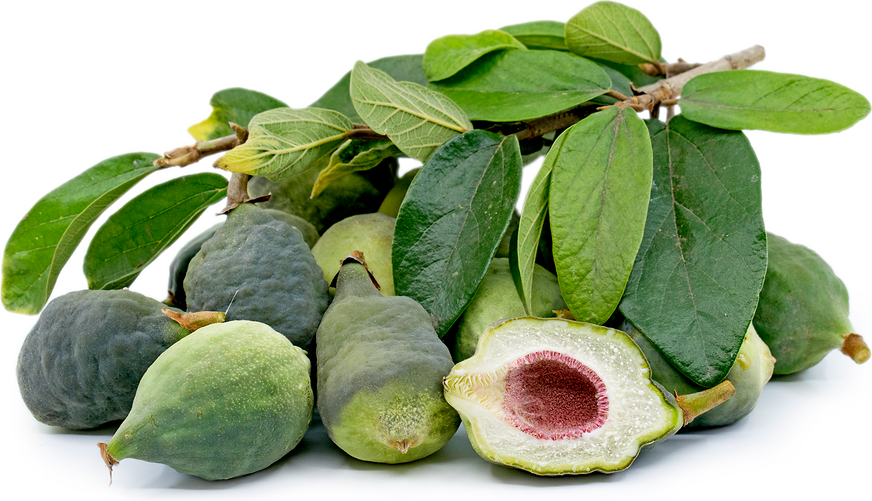


Taiwanese Jelly Figs
Estimated Inventory, lb : 0
Description/Taste
Taiwanese Jelly figs have an elongated bell shape, characterized by wide, rounded shoulders and a tapered, pointed bottom. Some fruits may have an elliptical shape while others are more ovate. When ripe, these figs typically measure about 6 to 8 centimeters in length. Their skin transitions from lime green with light green spots to deep purple with yellow spots as they ripen, often featuring a faint white residue on the surface. Taiwanese Jelly figs contain a thin outer layer of succulent light green flesh surrounding a seed cavity that makes up the majority of the fruit. This vibrantly colored cavity has a fibrous structure made up of translucent thread-like strands embedded with golden-orange jelly flesh and tiny brown seeds dispersed throughout. The glossy, gelatinous flesh of Taiwanese Jelly figs is known for its juiciness, complemented by tropical notes of pineapple, honey, berry, and a mild tangy sweetness.
Seasons/Availability
Taiwanese Jelly figs are available year-round with peak seasons in the fall and spring.
Current Facts
Taiwanese Jelly figs are botanically known as Ficus pumila var. awkeotsang and belong to the Moraceae family, which includes other tropical fruits like breadfruit, banyan, mulberries, and jackfruit. These figs are commonly referred to as Aiyu, Jelly figs, and Climbing figs. They are unique to their native Taiwan as this is the only place their pollination can occur because it requires the help of a fig wasp that doesn’t exist elsewhere. These tiny wasps enter the fruit to lay their eggs, helping the figs ripen in the process. Once the female figs are ripe, their seeds are collected, and by kneading them in water, the jelly-like texture of the fruit can be achieved. These figs are primarily used to make a preserve called Aiyu jelly, a popular culinary ingredient in Taiwan.
Nutritional Value
Like all fig varieties, Taiwanese Jelly figs are a good source of vitamins A and C. These vitamins support healthy skin and vision, immune function, collagen production, and protection from oxidative stress and free radical damage. They also contain calcium and iron, aiding in bone health, muscle and nerve function, oxygen transportation, and energy production. These fruits supply potassium and magnesium, essential nutrients that support fluid balance, heart health, healthy blood pressure, mood regulation, and improved sleep quality. Taiwanese Jelly figs are naturally high in pectin, a soluble fiber that aids digestion, promotes feelings of fullness, lowers cholesterol and blood sugar levels, and helps prevent free radical cell damage. Historically, these fruits have been used to treat fevers, curb hunger, aid in weight loss, and as a skincare ingredient.
Applications
Taiwanese Jelly figs are rarely eaten fresh and are primarily used for making Aiyu jelly. This jelly has a texture like gelatin and is made by turning the mature fruits inside out, drying them, scraping the seeds into a filter bag, and rubbing the bag in cold water to release gelatinous compounds. After 20 minutes, a thickened jelly is created and honey or lemon is frequently added for flavor. Aiyu jelly is commonly mixed with sodas, fruit juices, boba teas, and beer. It may also serve as a topping for shaved ice or fruit bowls with mangoes, lychee, strawberries, and kiwi. In savory dishes like bak kut teh, Aiyu jelly can substitute for lard, adding texture to the rich mushroom-based broth made with Xinshe shiitake, porcini, sautéed abalone, and king oyster mushrooms. Taiwanese Jelly figs pair well with ingredients like lime, basil, passion fruit, pineapple, melon, cantaloupe, watermelon, wax apples, grapes, taro, tapioca balls, chia seeds, candied fruits, and cola sodas. When made into Aiyu jelly, these figs can be stored in the refrigerator for up to a week.
Ethnic/Cultural Info
The first person to discover that Jelly figs could be turned into a preserve was a Taiwanese fruit trader traveling through the Chiayi County of Tawain in the 1820s. While there, he happened upon a stream where he noticed how these fig seeds created a gelatinous, pulpy texture when they fell into the water. He took the seeds home, mixed them with sugar, and created an amber-colored jelly. With the help of his daughter and the jelly's namesake, Ai-yu, the man started producing and selling the jelly throughout the country. Since then, Aiyu jelly has become a popular ingredient in Taiwanese desserts and drinks. It's now available across Southeast Asia in shops and local street vendors where it's often featured in beverages like Boba tea or paired with longans, lychees, or calamansi juice.
Geography/History
Taiwanese Jelly figs are native to Taiwan and grow exclusively there, relying on the fig wasp for pollination and fruit production. They grow on trees in the tropical and subtropical areas of Taiwain but are primarily cultivated in the Dapu Township of Chiayi County. These fruits can be foraged from natural forests across the island but are also commercially cultivated. Taiwanese Jelly figs were once a local delicacy of the Taiwanese people, who value it for its medicinal properties. When the advent of Aiyu jelly was discovered in the early 1800s, this product became widely available at night markets and local stalls throughout the streets of Taiwan. The jelly gained international appeal when Taiwan was under Japanese rule in the 1920s, leading to frequent exports of Taiwanese Jelly figs to Japan. Its growing popularity also inspired chefs at Michelin-recommended restaurants to incorporate it into creative dishes. Today, Taiwanese Jelly figs are most commonly found in their jelly form across Southeast Asia, particularly in their native Taiwan, as well as in Japan, Vietnam, China, and Malaysia, where they can be spotted at night markets, corner stores, and small alleyway shops.
Podcast




